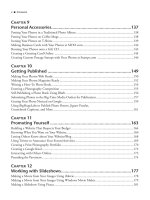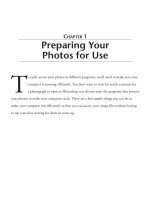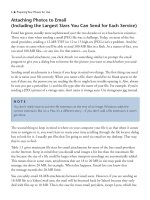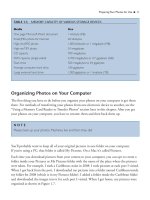Customer service training 101 quick and easy
Bạn đang xem bản rút gọn của tài liệu. Xem và tải ngay bản đầy đủ của tài liệu tại đây (703.25 KB, 239 trang )
101
CUSTOMER SERVICE
TRAINING
S E C O N D
E D I T I O N
Renée Evenson
AMERICAN MANAGEMENT ASSOCIATION
New York • Atlanta • Brussels • Chicago • Mexico City • San Francisco
Shanghai • Tokyo • Toronto • Washington, D. C.
Bulk discounts available. For details visit:
www.amacombooks.org/go/specialsales
Or contact special sales:
Phone: 800-250-5308
Email:
View all the AMACOM titles at: www.amacombooks.org
This publication is designed to provide accurate and authoritative information in regard
to the subject matter covered. It is sold with the understanding that the publisher is
not engaged in rendering legal, accounting, or other professional service. If legal advice
or other expert assistance is required, the services of a competent professional person
should be sought.
Library of Congress Cataloging-in-Publication Data
Evenson, Renee, 1951Customer service training 101 : quick and easy techniques that get great results /
Renee Evenson. —2nd ed.
p. cm.
Includes bibliographical references and index.
ISBN-13: 978-0-8144-1641-9 (alk. paper)
ISBN-10: 0-8144-1641-1 (alk. paper)
1. Customer services. 2. Customer relations. 3. Employees--Training of. I. Title.
HF5415.5.E89 2011
658.3'1245—dc22
2010020923
© 2011 Renée Evenson
All rights reserved.
Printed in the United States of America.
This publication may not be reproduced, stored in a retrieval system, or transmitted in
whole or in part, in any form or by any means, electronic, mechanical, photocopying,
recording, or otherwise, without the prior written permission of AMACOM, a division
of American Management Association, 1601 Broadway, New York, NY 10019.
About AMA
American Management Association (www.amanet.org) is a world leader in talent
development, advancing the skills of individuals to drive business success. Our mission
is to support the goals of individuals and organizations through a complete range of
products and services, including classroom and virtual seminars, webcasts, webinars,
podcasts, conferences, corporate and government solutions, business books, and
research. AMA’s approach to improving performance combines experiential learning—
learning through doing—with opportunities for ongoing professional growth at every
step of one’s career journey.
Printing number
10 9 8 7 6 5 4 3 2 1
C O N T E N T S
Acknowledgments vii
Introduction 1
Tips for the Trainer 5
Tips for the Student 13
P A R T
I
PUTTING YOUR BEST FACE FORWARD
1 Taking Your First Steps: The Basics 21
Customer Service Is the Basics, 22
Step 1: First Impressions Matter 25
Step 2: Courtesy Counts 27
Step 3: Attitude Is Everything 30
Step 4: Doing the Right Thing: Ethical Issues 32
■
Key Points 37, Practice Lesson 38, Doing It Right! 39,
How Do I Measure Up? 40
2 Tossing the Ball Back and Forth: Effective Communication 41
Customer Service Is Effective Communication, 42
Step 1: Saying What You Mean and Meaning What You Say 46
Step 2: What You Don’t Say: Nonverbal Communication 48
Step 3: Putting Words Together: Grammar Usage 51
Step 4: Asking the Correct Questions and Answering the Questions Correctly 52
Step 5: When the Customer Says No 56
iii
iv
Contents
Step 6: Listening Actively 59
■
Key Points 63, Practice Lesson 64, Doing It Right! 66,
How Do I Measure Up? 67
3 Jumping in with Both Feet: Relationship Building 68
Customer Service Is Building Relationships, 69
Step 1: Establishing Rapport 74
Step 2: Interacting Positively with Customers 77
Step 3: Identifying Customers’ Needs 79
Step 4: Making the Customer Feel Valued 82
Step 5: Maintaining Ongoing Relationships 83
Step 6: Different Strokes: Handling Different Types of Customers 86
■
Key Points 93, Practice Lesson 94, Doing It Right! 96,
How Do I Measure Up? 97
P A R T
II
PUTTING YOUR CUSTOMERS FIRST
4 Seeing Eye to Eye: Face-to-Face Contacts 101
Customer Service Is Face-to-Face Contacts, 102
Step 1: Saying Hello: Greeting the Customer 106
Step 2: Between Hello and Goodbye: Helping the Customer 109
Step 3: Saying Goodbye: Ending the Interaction 111
■
Key Points 117, Practice Lesson 117, Doing It Right! 118,
How Do I Measure Up? 120
Contents
5 Saying It with a Smile: Telephone Contacts 121
Customer Service Is Telephone Contacts, 122
Step 1: Putting Your Best Ear Forward: Listening Carefully 126
Step 2: Saying Hello: The Opener 127
Step 3: Between Hello and Goodbye: Helping the Customer 129
Step 4: Saying Goodbye: The Closer 133
■
Key Points 138, Practice Lesson 139, Doing It Right! 140,
How Do I Measure Up? 142
6 Looking Before You Leap: E-Customer Contacts 143
Customer Service Is E-Customer Contacts, 144
Step 1: What Does the E-Customer Expect? 147
Step 2: Hanging the Open Sign: Being Accessible 150
Step 3: Writing What You Mean: E-Mail Communication 152
Step 4: Speaking Around the World: Cross-Cultural Etiquette 155
■
Key Points 158, Practice Lesson 159, Doing It Right! 160,
How Do I Measure Up? 161
7 Giving When Getting Is Not Expected: Self-Service
Contacts 162
Customer Service Is Self-Service Contacts, 163
Step 1: Saying Hello: Greeting the Customer 167
Step 2: Between Hello and Goodbye: Looking for Opportunities to Help 169
Step 3: Saying Goodbye: Ending the Interaction 171
■
Key Points 176, Practice Lesson 176, Doing It Right! 178,
How Do I Measure Up? 179
v
vi
Contents
8 Calming the Storm: Difficult Customer Contacts 180
Customer Service Is Difficult Customer Contacts, 181
Step 1: What Is Going On: Determine the Reason for the Problem 184
Step 2: What Caused the Problem: Identify the Root Cause 188
Step 3: What Can I Do: Rectify the Situation 191
Step 4: What Can I Say: Restore the Relationship 194
Step 5: What Needs to Be Done: Fix What Needs to Be Fixed 197
■
Key Points 201, Practice Lesson 202, Doing It Right! 205,
How Do I Measure Up? 207
P A R T
III
PUTTING IT ALL TOGETHER
9 Hitting the Ground Running: Ready, Set, Go 211
Customer Service Is Being Ready and Set to Go 212
Your Customer Service Training Quick Reference 215
10 Being the Best You Can Be: The Total Package 218
Customer Service Is Being the Best You Can Be Every Day 218
Always Be Your Best! 221
Index 223
A C K N O W L E D G M E N T S
My deep appreciation to . . .
My editor, Bob Nirkind. Thank you! You illustrated what
exceptional customer service is all about by listening well and
by offering insightful, constructive suggestions and solutions
that made me a better writer.
My copyeditor, Barbara Chernow. Thank you for paying attention
to all the details, both small and large.
My agent, Michael Snell. Thank you for watching out for my best
interests, for being my toughest critic, and for giving me advice
that is always on target.
My husband and best friend, Joseph Balka. Thank you for always
giving me great advice and ideas.
My mother, Rose. Thank you for being my extra eyes and catching
the small details that I seem to miss.
My brother, Don. Thank you for lending your training expertise
and giving me spot-on advice for the training tips sections.
My sister and training partner, Sharon. Thank you for always being
there when I need an honest opinion.
My clients. Thank you for showing me how to give you the same
level of customer service that I coach you to give your customers.
I listen closely to what you want and then do my best to provide
it to you.
My family and friends. Thank you for helping me be the best I can
be every day.
I am deeply grateful for each and every one of you.
—Renée Evenson
vii
This page intentionally left blank
Introduction
We are slowly coming out of the worst recession in more than a generation. It is estimated that millions of businesses closed their doors.
Numerous others filed for bankruptcy protection. Experts acknowledge
that recovery will be very slow, which means that more businesses are
likely to close their doors.
With consumer confidence and customer loyalty at an all-time low,
providing exceptional customer service is no longer an added benefit; it
is a necessity. Customers who are not satisfied with the way they are treated are jumping ship and taking their business elsewhere. Customer loyalty can be your key to restoring consumer confidence, which can keep your
business afloat. Can you afford not to read this book? Think about it this
way: Giving your customers an exceptional experience will bring an
unexpected result: your customers become a marketing tool for your business. Customers talk. When people hear good things about your business,
they are more likely to do business with you as well.
Whether you are reading this book for the first time or already own
the first edition, this new and improved version is your one-stop shop to
learn and teach how to give exceptional customer service.
In addition to being thoroughly revised and updated throughout, this
edition includes a new chapter:
■
Giving When Getting Is Not Expected: Self-Service Contacts explains
how to provide a great customer experience when your customers
least expect it.
1
2
Introduction
Moreover, each chapter has been expanded to include:
■
The wrong way/right way to handle contacts.
■
Tips and topics for brainstorming discussions.
■
A new feature, Business NOT as Usual, that provides ideas
and tips for sustaining your business during tough times.
■
A revised Practice Lesson.
■
A new feature, Doing It Right!, that highlights a personal story.
■
A new feature, How Do I Measure Up?, that asks thoughtprovoking questions to help you analyze your skill level.
Every component of learning how to interact well with customers is
included:
■
Displaying courtesy and respect by making a great first impression,
speaking and acting appropriately, maintaining a positive attitude,
and acting ethically.
■
Communicating well by saying what you mean to say, projecting
proper body language, asking and answering questions correctly,
and listening carefully.
■
Building strong relationships by establishing a rapport, interacting
positively with customers, identifying needs, and finding the best
solution.
■
Handling customers skillfully in face-to-face, telephone, Web site,
and self-service settings.
■
Satisfying customers who are upset or difficult.
Customer service training benefits everyone involved. Your customers will feel valued and appreciated. Your employees will gain more
job satisfaction, take personal responsibility for customers, and have pride
Introduction
in knowing they are doing their best. You will become more customer
focused and seek out ways to continually improve. Your business will
experience increased efficiency and effectiveness.
Can you afford not to read this book? The answer is simple: Providing
great customer service costs much less, in dollars and sense, than providing poor service. It costs more to gain new customers than it does to
maintain existing ones. Customers will be more loyal to your business
when you treat them well. This book provides you with the tools to make
the difference with your customers.
Finally, it is always cheaper and faster to do the job right the first
time. Satisfying an unhappy customer costs a lot more, both in dollars and
cents, than satisfying a customer on the first try. Reading this book will
show you how to do that.
3
This page intentionally left blank
Tips for the Trainer
TRAINING SESSIONS SHOULD
BE A POSITIVE EXPERIENCE
FOR BOTH THE TRAINER AND THE TRAINEE
A trainer's most important role is to ensure that the frontline employees
learn the fundamentals of providing exceptional customer service to
every customer all the time. Investing the time to train your employees
can be a fun and positive experience for both you and them.
Whether you are training your employees, your coworkers, a group of
employees you were hired to train, or your students in school, thorough
preparation will enable you to make the most out of your classes.
Preparation before you begin will help you feel comfortable and confident and will take the guesswork out of your expectations. Preparation
includes identifying your training needs, defining learning outcomes,
planning your teaching lessons, establishing time frames for training sessions, preparing yourself for the training, setting up the room, and following up after the training.
5
6
Tips for the Trainer
IDENTIFY YOUR TRAINING NEEDS
To identify your training needs, answer this question: Why did you decide
to conduct customer service training? Your immediate response might be
“because we need it,” but to answer this question reflectively you must
first analyze and identify what needs to be improved from both your business and your employees’ perspectives.
First, focus on your business. Make a list of your customer service
training needs as they specifically relate to the type of products or services you provide, as well as your customers’ needs. As you read through the
book, relate the material to your business. For example, when reading the
chapter on telephone contacts, you may have an “aha” moment and realize that your employees answer the phone in an unprofessional manner.
Next, focus on your employees’ needs. Make a customer service learning outcome list for each employee. Note strengths, areas of improvement, additional technical or job skills training needed, and any behavioral issues (such as a poor attitude toward customers) that need to be
addressed.
DEFINE LEARNING OUTCOMES
Review the needs you identified and develop a list of realistic learning
outcomes. What skills should all of your employees demonstrate at the
end of the training session? It might help to note each chapter title and
make a list of the skills in which your employees should be proficient.
Using the example of employees answering calls in an unprofessional manner, one learning outcome for that chapter could be: Answer the
telephone as ABC Company, then (employee’s first name), then how
may I help you? Listing specific outcomes before you begin training will
enable you to measure how well your employees are using their new skills.
Tips for the Trainer
If you identified behavioral issues, you may want to make a separate
list for those employees. This will help you focus on those items throughout the training sessions and follow up afterward.
PLAN YOUR TEACHING LESSONS
Create an introduction to kick off the training. Keep in mind that you
will have everyone’s undivided attention—during the first few minutes of
speaking! Use this to your advantage and develop a strong introduction.
Keep it short and stick to the basics. Explain why you are conducting this
training and discuss general learning objectives. Then ask a question, tell
a customer service story, or begin with a warm-up exercise or game. Make
these first few minutes grab your students’ attention. As you work
through each chapter (those applicable), try this approach:
■
Begin each chapter by relating a positive personal experience
in which you were a customer (or ask for a student to volunteer)
and __________(fill in the blank to relate to the chapter material).
For example, for Chapter 1, your example could be where you
were a customer and formed a great first impression of an employee.
Discuss the impact of the positive experience.
■
Ask an open-ended question relevant to the example you cited.
For example: Why is it important to present yourself positively at all
times? Allow everyone to answer and discuss.
■
Work through the material step by step. Vary your delivery by
reading out loud to the students, having them take turns reading
out loud, or reading to themselves.
■
Throughout each chapter, ask discussion questions related
specifically to your business. For instance, What are some things
we should do to make a positive first impression?
7
8
Tips for the Trainer
■
After reviewing each chapter, plan a group activity. Suggestions are:
■
Divide the group into teams. Assign a customer-related
problem, dilemma, or question. Specify a time period for solving
the problem. Each team will then present its solution to the
group. Debate and choose the best solution.
■
Divide the group into role-play pairs. Give each pair a customer
service scenario and some additional details to help them get
into their roles. For example, the customer is upset with your
company and the employee has a condescending attitude.
Have one student play the role of the customer and another
play the customer service employee. First have students role
play the contact the wrong way, then again, role playing using
the skills they are learning.
■
To energize the class, play a game related to the material.
For example, after completing a session, have the group
members close their books and call out the key points for the
chapter they just completed. Toss a piece of candy to students
as they answer correctly. Another option is to have a student
call out an answer, then toss a ball to another person who
must call out an answer.
■
Review and recap the key points. Have students complete the
Practice Lesson and discuss their answers.
■
Have students complete How Do I Measure Up? Encourage them
to honestly analyze their skill levels.
ESTABLISH TIME FRAMES
FOR TRAINING SESSIONS
Now that you have reviewed the training material and planned your lessons, you should be able to establish time frames. Think about your hours
of operation, busy periods, and employee coverage. It is most effective, and
Tips for the Trainer
probably easiest, to cover the material in multiple sessions. This allows students to become comfortable with the material learned in each chapter.
When scheduling your classes, add a little extra time to your estimate
to make sure your students will not feel rushed. Write a schedule to which
you can conform. You will lose credibility with your employees if you
schedule a class and then cancel. Give your training sessions top priority.
If you demonstrate that customer service training is important to you,
learning customer service skills will be important to your employees.
PREPARE YOURSELF FOR THE TRAINING
When you train, establish an open and relaxed atmosphere that encourages discussion by maintaining a positive attitude, keeping focused,
remaining neutral, staying relaxed, encouraging everyone to participate,
and focusing on goals.
Rehearse and practice your presentations—both the general introduction and how you plan to handle each chapter. It is perfectly normal
to feel nervous, particularly if training is not part of your routine responsibilities. Being well prepared will help you manage your nerves. Practice
may not make perfect, but it will help you gain confidence and feel more
assured. Here are some tips for training others:
■
Focus on your students rather than on yourself.
■
Keep in mind the importance of the material.
■
Stay on track by making good notes—and using them.
■
Try to stick to the allotted time, but be sure you plan enough
time to be thorough. Do not rush against a time clock. It is better
to adjust the time than the material.
■
When you speak, make eye contact with your students, switching
your gaze from one person to another in a pace that is comfortable,
not staged.
9
10
Tips for the Trainer
■
Vary your voice tone and inflection.
■
Be yourself. Act naturally.
■
If you become nervous, take slow, deep breaths to calm yourself.
SET UP THE ROOM
Plan a setting conducive to training. First, find a suitable room or area
that is free from distractions and noise. For a small group, a u-shaped, rectangular, or round table works well. This way the students can face each
other for discussions, and you will be able to move easily within and
around the group. If you will be using an easel or chalkboard for discussion answers, place it so that all students can see it.
Think of ways to energize your students. Look for signs of tiredness or
boredom—yawning, fidgeting, or a glazed-over look. Here are some tips
for energizing your group:
■
Schedule short breaks every hour or two.
■
Lead frequent stretching or deep breathing exercises.
■
Vary the class activities.
■
Keep the class interactive by leading frequent discussions and
other activities.
FOLLOW UP AFTER THE TRAINING
Spend time with your employees to observe their customer contacts. Try
to catch them “doing it right.” When they do, acknowledge good performance by giving feedback that is specific to the behavior you observed.
Tips for the Trainer
Rather than saying, “you did a great job,” be more specific by saying, “I
really liked the way you handled Mrs. Johnson when she was upset. The
way you explained our delivery schedule was right on target, and you
made sure she understood completely. Great job.” Now your employee
knows exactly what was done right, and the behavior is more apt to be
repeated.
It can be a great motivator to praise an employee in earshot of other
employees, but it is never acceptable to discuss poor performance in public. When you hear an employee handling a customer poorly, take that
employee aside to discuss the incident.
Recognize your group’s efforts by commending them, by awarding
total team efforts, and by reading customer commendations at meetings.
Most importantly, be consistent with your team. Recognizing good
behavior yesterday but ignoring it today will confuse your employees.
Make sure customer service is important to you every day; then it will be
important to your employees every day, as well.
11
This page intentionally left blank
Tips for the Student
WELL-TRAINED EMPLOYEES ARE
THE KEY TO SATISFIED CUSTOMERS
Why is customer service training important? The answer is simple: treating your customers well is essential to your company and to your job.
Learning how to give exceptional customer service is necessary for any
business to succeed.
What can happen if customer service is not important to a business?
PICTURE THIS:...
THE WRONG WAY TO HANDLE CUSTOMERS
Kris began a new job working in a gift shop. She enjoyed stocking shelves
and arranging merchandise in the display cases and window. She also
got along well with her coworkers and manager, who joked around and
had a good time. They even had an inside joke that it would be nice if
customers did not bother them. When a customer came in, they would
busy themselves with their “real work,” ignoring the shopper until they
were asked for help; they would then make jokes in the back room about
who got stuck handling the customer.
13
14
Tips for the Student
After Kris had been working in the shop a few months, she noticed
that fewer customers were coming in than when she first started. Business
was dropping off. The employees enjoyed the relaxed atmosphere and had
more time to joke around.
One day their manager held a meeting. She told the employees that
their sales had been declining to the point that without sufficient sales
revenue the company could not afford to keep all of them. Not long
afterward, Kris and most of the other employees were let go.
Kris was upset. She liked working in the gift shop because it was so
much fun. But she was upset for the wrong reason. Had it not been for
the attitude she and her coworkers shared, the shop may not have lost business and have had to let employees go. Having fun on the job is fine, but
Kris did not understand the most important rule of working in the
customer service field: CUSTOMERS = REVENUE = WAGES = EMPLOYEES.
Customer service training is important because customers have many
choices. If they are not happy with the way they are treated, they can take
their business elsewhere, as did the customers in the scenario above.
Customers are the Reason You Have a Job!
If Kris and her coworkers had been taught this simple principle, they
would have treated their customers differently.
PICTURE THIS...
THE RIGHT WAY TO HANDLE CUSTOMERS
Kris began a new job working in a gift shop. On her first day, her
manager trained Kris on her job duties, which included stocking shelves
and arranging merchandise in the display cases and window. Her most
important job, her manager stressed, was to help customers when they
came in. No matter what Kris was doing, when a customer came in,
she was to focus her attention on helping that customer. Her manager
Tips for the Student
specifically explained the procedures and expectations for helping
customers from the time they walked into the shop until the time they left.
Kris enjoyed stocking shelves and arranging merchandise in the display
cases and window. She also got along well with her coworkers, who joked
around and had a good time. When customers came in, they were given
top priority, no matter what the employees were doing. Because the
manager explained the importance of customers, Kris and her coworkers
understood that helping customers was their most important job.
The manager held weekly group meetings. She kept the group up
to date on sales revenue data, consistently discussed the importance of
customer service, and praised exceptional behavior.
Kris enjoyed the relaxed atmosphere, where everyone worked to
achieve the clearly stated company goals. Kris found tremendous job
satisfaction helping customers in the gift shop.
Whether your manager purchased this book for a training class, you
purchased this book to improve your skills, or you are using it for a class
in school, you are going to learn how to present yourself well and how to
handle different types of customers in varying situations.
Before you begin your training classes or reading the book, it will be
beneficial to identify your personal needs and define learning outcomes.
This will help you prepare for learning new skills, enable you to get the
most out of the material, and help you self-monitor after training.
IDENTIFY YOUR PERSONAL NEEDS
AND DEFINE LEARNING OUTCOMES
Think about your typical customer contacts. Which types of customers or
customer interactions are you uncomfortable handling? For example, are
you unsure how to talk to customers who are upset and confront you in
an angry tone? Make a list of any areas in which you need improvement
or guidance.
15
16
Tips for the Student
Now, think about your job from a technical standpoint. What must
you learn to do your job effectively? Make a list of those areas in which
you need additional training. Before you begin your customer service
training, give this list to your manager and ask for the technical training
you need. You must feel comfortable with your job duties before you can
feel comfortable helping each customer.
Finally, think about what you want to gain from training. Make a list
of learning outcomes. Turn your areas of improvement into learning outcomes by rephrasing them as positive statements. For example, not knowing how to deal with customers who are angry could be written as a learning objective: turn irate customers into satisfied ones.
PREPARE FOR THE TRAINING SESSION
Whether you are a student in a class or working through the material on
your own, reading and learning puts you into a different routine. When
you are used to working with customers and coworkers, staying alert when
you sit, read, and work through a book can be difficult. Make the most of
the training sessions by:
■
Getting enough sleep the night before training.
■
Eating a healthy breakfast.
■
Knowing what to expect during the class.
■
Taking deep breaths when you feel drowsy.
■
Standing and stretching when you feel sleepy.
■
Taking a short walking break when you feel ready to nod off.









